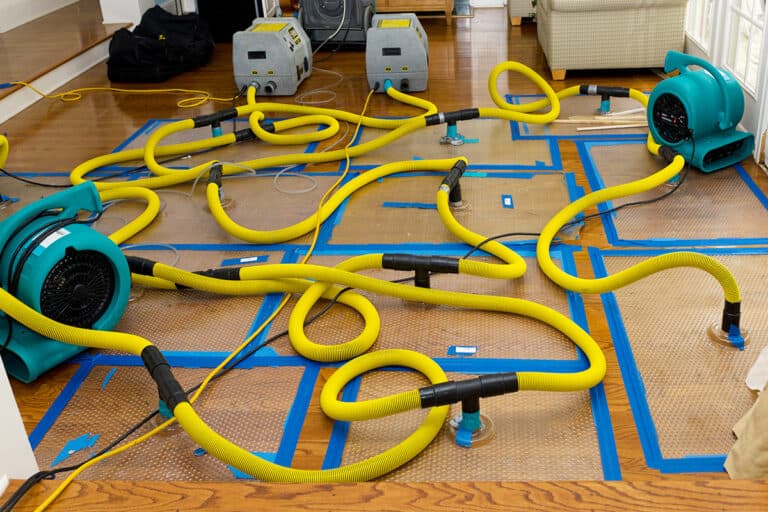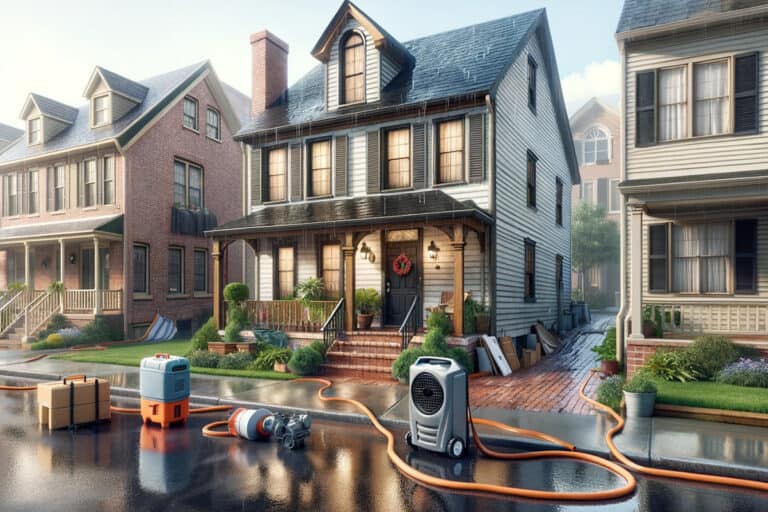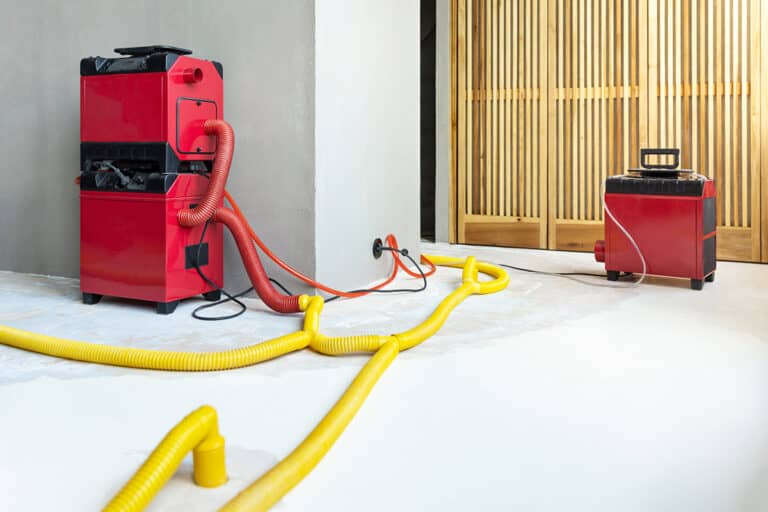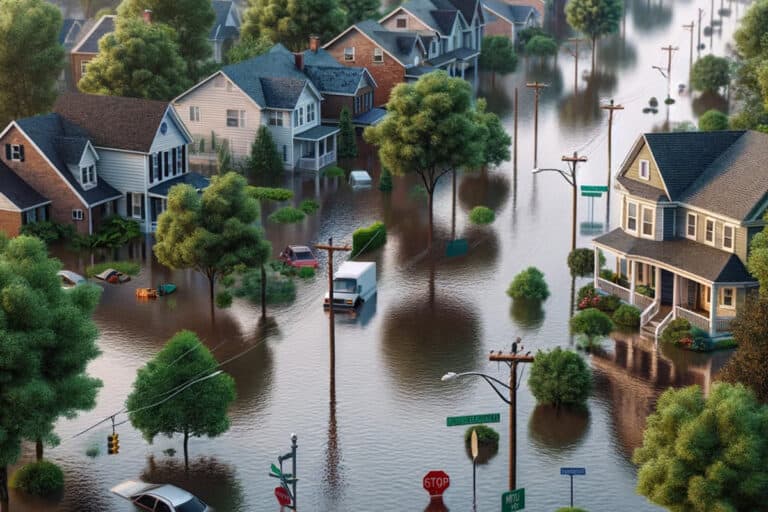Disclosure: I am compensated for purchases made through some links on this site. Click for details.
Water damage is one of the most common and costly problems that homeowners face. It can be caused by various factors, such as leaks, floods, storms, or faulty plumbing. However, not all water damage is the same. Depending on how long the water has been in contact with the affected area, water damage can be classified as new or old.
Knowing the difference between new and old water damage is crucial for determining the best course of action and preventing further damage and health risks. Beyond surface staining and warping, chronic moisture issues open up the insidious threats of mold growth, respiratory health hazards, and structural instability. Catching and treating water damage early is crucial to avoid these worsened issues down the line.
In this blog post, we will explain how to tell if water damage is new or old, and why it matters. We will also provide some tips on how to prevent and fix water damage in your home, and why you should hire a professional water damage restoration service.
How to Tell If Water Damage Is New or Old
Catching and treating moisture issues early before they proliferate makes a huge difference. But what signals recent leaks versus more concealed, chronic wetness?
New Water Damage
- Wet, darkened areas
- Fresh stains lacking rings
- Mushrooming “new mold” growth
- Recent appliances/sites of leaks
- Soft, spongy textures
Old Water Damage
- Faded, lighter stains
- Concentric water rings
- Powdery residue mold sites
- Historical insulation/roof issues
- Rotting, crumbly drywall
Getting professional assessments at first signs allows prompt response before lasting corrosion and health hazards take hold.
Table 1: Comparison of New vs. Old Water Damage Signs
| Sign | New Water Damage | Old Water Damage |
|---|---|---|
| Location | Often isolated near appliance/leak source | Spread out from source |
| Texture | Wet, spongy | Brittle, crumbly |
| Color | Dark stains | Faded, light stains |
| Rings/Patterns | No rings | Concentric rings |
| Mold Growth | Dark “new mold” | White, powdery residue |
| Smell | Strong musty smell | Faint musty smell |
How to Detect the Signs of Old Water Damage
Water damage encompasses categories from immediate “Category 1” flooding to longer-standing “Category 3” conditions indicating leaked moisture spread over time. If suspected chronic problems are not identified and treated promptly, further structural and indoor air quality decay will accelerate.
1. Looking Into Your Home’s History
One of the easiest ways to tell if water damage is new or old is to check the history of the home. If you know when the last time the home was inspected, repaired, or renovated, you can have a better idea of how long the water damage has been there.
For example, if you notice water stains on the ceiling, and you know that the roof was replaced a year ago, you can assume that the water damage is new. However, if you notice water stains on the wall, and you know that the wall has not been painted or repaired for a long time, you can assume that the water damage is old.
Check any records from:
- Recent or past renovations showing repaired vs unaddressed water stains
- Consult inspector’s notes when the home was purchased
- Recall any past visible leakage sites, flooding incidents
- Plumbing repairs or appliance replacements
Comparing fresh marks vs water rings elsewhere can reveal the relative age of various water-affected areas.
2. Tactile and Visual Cues Revealing Age
Another way to tell if water damage is new or old is to touch and look at the affected area. Generally, new water damage will feel wet, soft, and spongy, while old water damage will feel dry, hard, and brittle. Similarly, new water damage will have a darker color, while old water damage will have a lighter color.
For example, if you touch a water spot on the carpet, and it feels wet and soft, and has a dark brown color, you can assume that the water damage is new. However, if you touch a water spot on the wood floor, and it feels dry and hard, and has a light yellow color, you can assume that the water damage is old.
Texture and Firmness
- Softer, spongy areas indicate retained moisture while hard, brittle zones suggest older water loss and material deterioration.
Color Changes
- Newer leaks or flooding tend to appear darker, while old sites lose water volume over time and fade to lighter staining.
- White, chalky discoloration reveals long years of saturation
Rings and Stain Shapes
- Concentric circles imply periods of water retention and evaporation in the same site
- Sharply defined outlines indicate one-time recent flooding versus blurred, creeping shapes tracing chronic moisture migration
3. Mold and Mildew Growth
Another way to tell if water damage is new or old is to check for the presence and spread of mold. Mold is a type of fungus that grows in moist and dark environments, and it can cause serious health problems, such as allergies, asthma, and infections.
Mold can develop within 24 to 48 hours after water damage, and it can spread to areas that are not visible, such as behind the walls or under the floor. Therefore, if you see any traces of mold on the affected area, you can assume that the water damage is at least a few days old.
However, the appearance and consistency of mold can also indicate the age of water damage. Newer mold will appear as black, white, or grey spots with a bushy consistency, while older mold will be dry and powdery.
For example, if you see black spots with a fuzzy texture on the wall, you can assume that the water damage is new. However, if you see white powder with a chalky texture on the ceiling, you can assume that the water damage is old.
- Fuzzy, blackish “new mold” arises in the first 24-48 hours from leaks, high humidity
- Powdery surfaced “legacy mold” suggests years of untreated dampness
4. Type of Material
Another way to tell if water damage is new or old is to examine the type of material that is affected by water. Different materials have different rates of absorption and deterioration when exposed to water.
For example, hard materials like tile and brick take longer to show water damage than soft materials like drywall and carpet. Therefore, if you see water damage on a hard material, you can assume that it is older than water damage on a soft material.
5. Other Clues Implying Hidden Water Damage
- Musty “wet dog” smells emerging from behind walls or ceilings
- Bubbling or cracked paint and plaster
- Warped floor sections or separating baseboards
- Doors and windows sticking suddenly
6. When to Engage Professional Water Damage Assessment
Since signs like mold and wall decay only emerge after significant moisture saturation, concealed leakage areas may be spreading aggressively by the time you spot visible clues. Thermal imaging, moisture probes, and other advanced diagnostics should investigate otherwise invisible red flags like:
- Cooler wall temperatures
- High wood moisture content
- Raised indoor humidity
Waiting leads to exponentially worse property damage and health impacts. Call water damage experts immediately if you notice multiple symptoms of chronic moisture issues.
Why It Is Important to Know the Age of Water Damage
Knowing the age of water damage is important for several reasons.
First, it can help you identify the source and cause of the water damage, and take the necessary steps to fix it. For example, if you know that the water damage is new, you can look for recent events or changes that might have caused it, such as a storm, a leak, or a burst pipe. However, if you know that the water damage is old, you can look for chronic or hidden problems that might have caused it, such as poor ventilation, faulty plumbing, or roof damage.
Second, it can help you assess the extent and severity of the water damage, and decide whether you can handle it yourself or you need professional help. For example, if you know that the water damage is new, you might be able to dry out and clean the affected area yourself, using some basic tools and techniques. However, if you know that the water damage is old, you might need to hire a professional water damage restoration service to remove the excess water, dry out the affected area, restore the damaged materials, and clean the space.
Third, it can help you prevent further damage and health risks from water damage and mold exposure. For example, if you know that the water damage is new, you can act fast and prevent the water from spreading and causing more damage. However, if you know that the water damage is old, you can take precautions and protect yourself from the potential health hazards of mold exposure, such as wearing protective gear, avoiding contact with the mold, and seeking medical attention if you experience any symptoms.
The Dangers and Risks of Old Water Damage
Beyond daily eyesores of flaking paint and warped floors, legacy moisture corrosion unleashes much more dire threats the longer it goes unaddressed:
Structural Instability and Decay
Rotting boards, eroded masonry, and corroded structural connectors undermine buildings’ capacities to withstand storms, earthquakes, snow loads, and normal use stresses over time. Sagging ceilings and jammed doors also progress, threatening sudden collapse.
Electrical System Hazards
Channels of water penetration eventually degrade connections, fixture housings, and circuit boards controlling critical systems like appliances, climate control, lighting, and electronic security. Shorts and fires ensue from deteriorated wiring breached by moisture. Replacing entire electrical systems can cost upwards of $10,000 alone.
Flood Vulnerability
Not only does enclosed leakage reduce structural integrity, but barriers meant to withstand high water exposure like exterior siding, foundation seals, and window frames also degrade over time. The next storm or broken main then penetrates much faster to wreak greater havoc. Recent research found homes with unrepaired water damage can suffer over 40% more flooding.
Mold Health Hazards
Inhaling or touching mold spores over 48 hours old launches allergenic compounds leading to:
- Itchy eyes, runny nose
- Skin irritation and rashes
- Wheezing and worsened asthma
- Lung inflammation causing chronic coughs
Once inside moisture enables mycotoxigenic molds to generate poisons, fatal conditions like pulmonary hemorrhage become possibilities requiring prompt mitigation.
Eventual Repair Costs
Catching and restoring hidden moisture damage in walls or under floors early before structural impacts emerge costs 60-70% less than after extensive mold and rot.
Table 2: Costs of Water Damage Repairs
| Phase of Repair | Services Included | Estimated Cost |
|---|---|---|
| Early Detection and Minor Restoration | – Inspection – Leak detection – Drying wet areas – Mold treatment up to 10 sq ft – Minor drywall repair | $500 – $2,000 |
| Moderate Water Extraction and Repairs | – Water extraction – Dry out wet walls/floors – Replace up to 50 sq ft of drywall – Painting – Floor/carpet cleaning | $2,000 – $8,000 |
| Major Flood Restoration | – Dry out flooded areas – Anti-microbial treatments – Replace drywall, insulation, flooring – Cabinet/furniture restoration – Full mold remediation | $8,000 – $15,000+ |
| Full Home Restoration After Structural Damage | – Stabilize foundation – Replace load-bearing walls/supports – New floor/roof decking – Full wiring/plumbing overhaul – All new interiors | $15,000+ |
The longer moisture issues persist unaddressed, the higher the final costs and repairs involved. Catching problems early saves tremendously on water damage restoration.
How to Prevent Water Damage in Your Home
Water damage can be a nightmare for homeowners. The best way to deal with water damage is to prevent it from happening in the first place. Here are some of the best ways to prevent and fix water damage in your home:
Professional Inspection
- Plumbers checking pipes
- Roofers after storm seasons
- Annual home inspectors assessing insulation, venting, leakage signs
Water Sensors
- Smart home monitors alerting to spikes in humidity levels
- Water leak detector pads installed in strategic under-appliance spots
- Flood detector cables laid out along plumbing paths
Gutter and Drainage Upkeep
- Semi-annual gutter cleaning
- Seasonal drain flushouts
- Keeping grade slopes descending away from foundations
Appliance and Plumbing Maintenance
- Replacing older pipes prone to cracks
- Fixing dripping faucets quickly
- Tuning up water heaters
- Upgrading failing appliances like AC units, dishwashers
DIY Checks and Improvements
While extensive water extraction and structural repairs require expert handling, some regular at-home checks and improvements homeowners can perform themselves include:
- Visually scanning walls, ceilings, and floors for new stains monthly – especially during and after heavy rains or plumbing repairs. Using a moisture meter on questionable spots identifies the worst areas.
- Checking on appliances monthly for leaks – refrigerators, washing machines and dishwashers being prime suspects. Tightening fittings and lines prevents rampant damage.
- Improving airflow to areas like attics and basements with venting additions and dehumidifier adjustments during wet, humid seasons. Keeping moisture content lower wards off material degradation and mold blooms.
- Reapplying caulk and grout around tubs, showers and sinks twice a year as they commonly crack over time. A $10 tube of sealant prevents a world of hurt!
- Monitoring sump pumps regularly to ensure proper functioning as building perimeter or foundation breaches first enable water intrusion. Backup units provide redundancy if primary systems fail.
The above takes little time or money but pays off greatly. Scheduling another full professional inspection at least every three years (or sooner if selling) provides expert insight and diagnostics letting you rest easy.
Prepare for Emergencies
You can also prepare for emergencies, such as storms, floods, or hurricanes, by securing your windows and doors, moving your valuables to higher ground, and having an emergency kit and a backup plan.
DIY Steps for Repairing Water Damage in Your Home
If you discover water damage in your home, you should act fast and follow these steps to fix it:
1. Stop the source of water
The first thing you should do is to stop the water from flowing and causing more damage. You can do this by turning off the main water supply, fixing the leak, or blocking the water entry point.
2. Remove the excess water
The next thing you should do is to remove the excess water from the affected area. You can do this by using towels, mops, buckets, wet vacuums, or pumps. You should also move any furniture, appliances, or belongings that are wet or damaged to a dry and safe place.
3. Dry out the affected area
The third thing you should do is to dry out the affected area as soon as possible. You can do this by using fans, dehumidifiers, heaters, or air conditioners. You should also open the windows and doors to allow air circulation and ventilation. You should also remove any carpet, padding, insulation, or drywall that is wet or damaged, as they can harbor mold and bacteria.
4. Clean and disinfect the affected area
The fourth thing you should do is to clean and disinfect the affected area to prevent mold growth and infection. You can do this by using soap, water, bleach, or vinegar. You should also wear protective gear, such as gloves, masks, and goggles, to avoid contact with the contaminated water and materials. You should also dispose of any items that are beyond repair or restoration, such as books, papers, or fabrics.
5. Restore and repair the affected area
The fifth thing you should do is to restore and repair the affected area to its original condition. You can do this by replacing any materials that are damaged, such as flooring, walls, ceilings, or furniture. You can also repaint, refinish, or redecorate the area to make it look new and fresh.
Why You Should Hire a Professional Water Damage Restoration Service
While some water damage situations can be handled by yourself, others might require professional help. Here are some of the reasons why you should hire a professional water damage restoration service to deal with water damage in your home:
Expertise and Experience
Professional water damage restoration services have the expertise and experience to handle any water damage situation, no matter how big or small, new or old, simple or complex. They have the knowledge, skills, and tools to identify the source and cause of water damage, assess the extent and severity of water damage, and provide the best solution for water damage restoration. They also have the certifications and licenses to comply with the industry standards and regulations.
Quality and Customer Service
Professional water damage restoration services have the quality and customer service to ensure your satisfaction and peace of mind. They have the equipment and materials to perform high-quality water damage restoration, such as water extraction, drying, cleaning, disinfecting, deodorizing, and restoring. They also have the staff and support to provide excellent customer service, such as 24/7 availability, fast response, free estimates, and warranty.
Free Estimate and 24/7 Support
Professional water damage restoration services offer free estimates and 24/7 support to help you with your water damage situation. You can contact them anytime
Professional Water Damage Restoration Process
Addressing all the subtle impacts of water damage often requires an orchestrated, multi-point approach that can’t be addressed as a do-it-yourself project. Professional water damage remediation includes the following steps:
1. Hunt Down and Stop Ongoing Leaks
Specialist tools like infrared cameras, moisture probes, smoke wands, and leak dye tests track down origin points around:
- Faulty roof membranes
- Deteriorated plumbing joints
- Appliance water line failures
- Foundation seep points
- HVAC overflow pans
Once identified, licensed contractors patch holes, replace defective materials completely, and shore up structural components permitting water intrusion.
2. Extract Excess Moisture
Truck-mounted vacuum extraction systems combined with dehumidifiers remove ambient humidity and liquify trapped water under and through materials quickly before further wicking and evaporation spreads growth and decay. Strategic drying also prevents warping and future watermarks.
3. Apply Antimicrobial Treatments
EPA-registered disinfectants formulated to halt mold fungus without damaging materials treat affected regions and inhibit further musty residue growth. Botanical solutions also remove existing spore and myotoxin deposits.
4. Tear Out and Replace Water-Ruined Areas
While surfaces like tile and metals may endure cleansing, gypsum wallboard, insulation, and degraded carpeting serve as reservoirs for microbes and moisture requiring removal. Technicians discard moldy materials and structurally replace compromised sections.
5. Execute Structural Repairs
Where critical stability supports like joists and bearing walls suffer damage from chronic leakage spread, waterproof epoxy injections, reinforcement rods, humidity regulators, and ventilation improvements restore integrity for future resilience.
6. Verify Air Quality
Final safety clearance tests checking for airborne particulates and lingering moisture ensures an environment hygienic and stable for re-occupancy. Certified professionals confirm issues will not return.
Choosing a Water Damage Restoration Company
Not all mitigation contractors offer full suites of remediation services required to tackle all challenges posed by concealed moisture deterioration decoded above. Key credentials and advantages include:
- IICRC Certification covering new, old, and structural water damage
- Infrared cameras and moisture probes to diagnose areas needing repair
- Truck-mounted vacuum extraction systems with the required reach
- Mold treatments following EPA guidelines to inhibit regrowth
- Structural drying programs and reinforcements restoring stability
- Scientific post-remediation air quality testing
- 24/7 emergency response availability
- Warranties covering full repairs and replaced components
FAQs About Old Water Damage
Take Action Now Against Water Damage Dangers
Left unchecked, buried moisture migration attacks all structural composites, nurtures allergenic contaminants, and elevates flood risks over time. Early identification and restoration contain dangers before they threaten not only cherished home values but health and safety too.
Don’t delay – protect your home and health today. Schedule an inspection if you notice any of these signs:
- Multiple visible water stains on walls, ceilings, or floors indicate uncontrolled spread
- Musty, moldy smells emerging from enclosed spaces
- Any signs of structural damage – sagging drywall, jamming doors/windows




